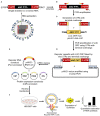A Comprehensive Roadmap Towards the Generation of an Influenza B Reporter Assay Using a Single DNA Polymerase-Based Cloning of the Reporter RNA Construct
- PMID: 35694292
- PMCID: PMC9174941
- DOI: 10.3389/fmicb.2022.868367
A Comprehensive Roadmap Towards the Generation of an Influenza B Reporter Assay Using a Single DNA Polymerase-Based Cloning of the Reporter RNA Construct
Abstract
The mini-genome reporter assay is a key tool for conducting RNA virus research. However, procedural complications and the lack of adequate literature pose a major challenge in developing these assay systems. Here, we present a novel, yet generic and simple, cloning strategy for the construction of an influenza B virus reporter RNA template and describe an extensive standardization of the reporter RNP/polymerase activity assay for monitoring viral RNA synthesis in an infection-free setting. Using this assay system, we showed for the first time the effect of viral protein NS1 and host protein kinase C delta (PKCD) on influenza B virus RNA synthesis. In addition, the assay system showed promising results in evaluating the efficacy of antiviral drugs targeting viral RNA synthesis and virus propagation. Together, this work offers a detailed protocol for the standardization of the influenza virus minigenome assay and an excellent tool for screening of host factors and antivirals in a fast, user-friendly, and high-throughput manner.
Keywords: antiviral screening; influenza B; polymerase activity assay; reporter construct; ribonucleoprotein.
Copyright © 2022 Kedia, Banerjee and Mondal.
Conflict of interest statement
The authors declare that the research was conducted in the absence of any commercial or financial relationships that could be construed as a potential conflict of interest.
Figures





Similar articles
-
Establishment of a High-Throughput Assay to Monitor Influenza A Virus RNA Transcription and Replication.PLoS One. 2015 Jul 21;10(7):e0133558. doi: 10.1371/journal.pone.0133558. eCollection 2015. PLoS One. 2015. PMID: 26196128 Free PMC article.
-
BPR2-D2 targeting viral ribonucleoprotein complex-associated function inhibits oseltamivir-resistant influenza viruses.J Antimicrob Chemother. 2010 Jan;65(1):63-71. doi: 10.1093/jac/dkp393. J Antimicrob Chemother. 2010. PMID: 19892833
-
Investigating Influenza Virus Polymerase Activity in Feline Cells Based on the Influenza Virus Minigenome Replication System Driven by the Feline RNA Polymerase I Promoter.Front Immunol. 2022 May 26;13:827681. doi: 10.3389/fimmu.2022.827681. eCollection 2022. Front Immunol. 2022. PMID: 35693765 Free PMC article.
-
Structural insights into RNA synthesis by the influenza virus transcription-replication machine.Virus Res. 2017 Apr 15;234:103-117. doi: 10.1016/j.virusres.2017.01.013. Epub 2017 Jan 20. Virus Res. 2017. PMID: 28115197 Review.
-
Focusing on the Influenza Virus Polymerase Complex: Recent Progress in Drug Discovery and Assay Development.Curr Med Chem. 2019;26(13):2243-2263. doi: 10.2174/0929867325666180706112940. Curr Med Chem. 2019. PMID: 29984646 Free PMC article. Review.
Cited by
-
Unlocking influenza B: exploring molecular biology and reverse genetics for epidemic control and vaccine innovation.Virol J. 2024 Aug 23;21(1):196. doi: 10.1186/s12985-024-02433-8. Virol J. 2024. PMID: 39180083 Free PMC article. Review.
-
The Species-Specific 282 Residue in the PB2 Subunit of the Polymerase Regulates RNA Synthesis and Replication of Influenza A Viruses Infecting Bat and Nonbat Hosts.J Virol. 2022 Mar 9;96(5):e0219021. doi: 10.1128/jvi.02190-21. Epub 2022 Jan 19. J Virol. 2022. PMID: 35044213 Free PMC article.
References
-
- CDC (2021a). U. S. Influenza Surveillance: Purpose and Methods | CDC. Available online at: https://www.cdc.gov/flu/weekly/overview.htm (accessed November 2, 2021).
-
- CDC (2021b). Flu Symptoms & Complications | CDC. Available online at: https://www.cdc.gov/flu/symptoms/symptoms.htm (accessed November 2, 2021).
LinkOut - more resources
Full Text Sources
Research Materials

